

|
Archives
e-books
I've tried reading e-books for several years now. The big problem has been the big computer. It doesn't go to where I like to read books, which is just about anywhere that I find myself. The Kindle
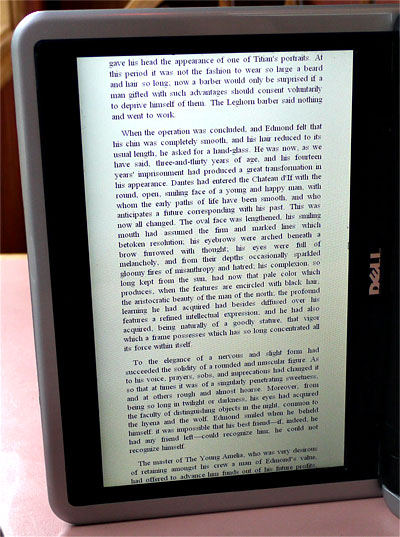 No, Dell isn't making a Kindle competitor.
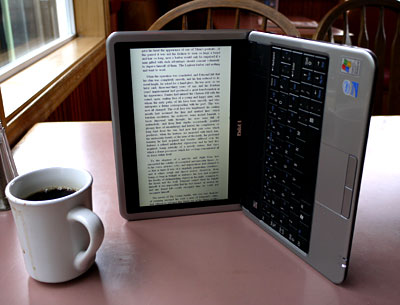 It's my 9" Dell Mini. My gosh, the text is rotated 90 degrees! How is this done?
"Among e-readers, the Kindle attracts the most attention due to its connection to Amazon for content and its easy-on-the-eyes E-Ink screen. But if you're already packing an XP-based netbook in a purse or briefcase, you can get much of the same functionality without carrying another device. Now wouldn't it be great if you could thumb through the pages vertically instead of scanning a squat, horizontal screen? You can. If your netbook has the Intel GMA Driver for Mobile Control Panel (most do), click the Display Settings tab, check Enable Rotation, and click the 270° radio button. Click Apply. Depending on your system, you might be able to press Ctrl-Alt-Right Arrow or Ctrl-Alt-Up Arrow to toggle between the normal and rotated orientations. If your machine doesn't have that video control panel or your key commands aren't working correctly -- mine didn't on an Acer Aspire One -- download EeeRotate. This free tool lets you easily toggle between the portrait and landscape orientations, using the same key commands noted above. And here is where you can get EeeRotate:
EeeRotate Program Gets You Disoriented The program is for Acer netbooks but it works fine on my Dell Mini. Cost (if you already have a netbook): $0. This will work on larger laptops but is ideal for the tiny netbooks. Where to get cheap E-books? Get thee to Project Gutenberg which has thousands of free books whose copyrights have expired. They are available in several formats. The book I'm reading, The Count of Monte Cristo, is in HTML so I read it in my browser. I go full screen to have only the text displayed. In Opera, my browser, you can change the size of the display from 20% to 1000%. I bumped up to size to 120% which works best for me. The Dell Mini is easy to carry around to any room I want and I can now read an e-book where ever and when ever I want.
movie recommendation
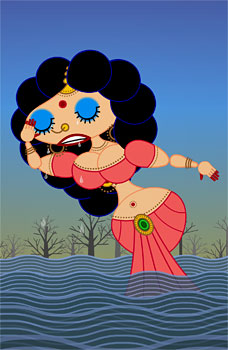 Sita Sings the Blues
This is the best movie you can't see. Well, you can't see it if you only see your movies in movie theaters. This is an independent animation of the Ramayana, along with a bit of autobiography. Nina Paley spent 5 years doing this on her home computer. Disney should be envious. You can't see it because of copyright restrictions on songs Annette Hanshaw sang in the 1930s in a case of copyright protection gone wrong. But you can see it online and you can buy a DVD from Nina. I highly recommend it. So does Roger Ebert.
Having a wonderful time, wish you could hear "It hardly ever happens this way. I get a DVD in the mail. I'm told it's an animated film directed by "a girl from Urbana." That's my home town. It is titled "Sita Sings the Blues." I know nothing about it, and the plot description on IMDb is not exactly a barn-burner: An animated version of the epic Indian tale of Ramayana set to the 1920's jazz vocals of Annette Hanshaw. Uh, huh. I carefully file it with other movies I will watch when they introduce the 8-day week. "I get an e-mail from Betsy, my old pal who worked with me on The News-Gazette. "Did you see the film by the mayor's daughter?" This intrigues me. The daughter is named Nina Paley. I do a Google run and discover that Hiram Paley was mayor from 1973-1977. I am relieved. This means the "girl" probably didn't make the film as a high school class project. In fact, by my rapid mathematical calculations, she may have been conceived in City Hall. I used to cover City Hall. Worse things have happened there. "By this point, I'm hooked. I can't stop now. I put on the DVD and start watching. I am enchanted. I am swept away. I am smiling from one end of the film to the other. It is astonishingly original. It brings together four entirely separate elements and combines them into a great whimsical chord. You might think my attention would flag while watching An animated version of the epic Indian tale of Ramayana set to the 1920's jazz vocals of Annette Hanshaw. Quite the opposite. It quickens. I obtain Nina Paley's e-mail address and invite the film to my film festival in April 2009 at the University of Illinois, which by perfect synchronicity is in our home town. "To get any film made is a miracle. To conceive of a film like this is a greater miracle. How did Paley's mind work? She begins with the story of Ramayana, which is known to every school child in India but not to me. It tells the story of a brave, noble woman who was made to suffer because of the perfidy of a spineless husband and his mother. This is a story known to every school child in America. They learn it at their mother's knee. Paley depicts the story with exuberant drawings in bright colors. It is about a prince named Rama who treated Sita shamefully, although she loved him and was faithful to him.
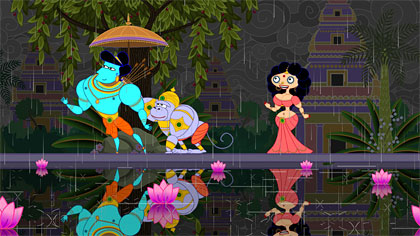 Rama, Hanuman the Monkey Warrior, and Sita
The Sita Sings the Blues website has information on where you can download copies of Sita Sings the Blues. "I hereby give Sita Sings the Blues to you. Like all culture, it belongs to you already, but I am making it explicit with a Creative Commons Attribution-Share Alike License. Please distribute, copy, share, archive, and show Sita Sings the Blues. From the shared culture it came, and back into the shared culture it goes. "You don't need my permission to copy, share, publish, archive, show, sell, broadcast, or remix Sita Sings the Blues. Conventional wisdom urges me to demand payment for every use of the film, but then how would people without money get to see it? How widely would the film be disseminated if it were limited by permission and fees? Control offers a false sense of security. The only real security I have is trusting you, trusting culture, and trusting freedom." Or you can see the whole thing on YouTube: Sita Sings the Blues The best bet is to order a DVD through the website and watch it on a High Def TV. Beautiful!! Let's hope the copyright restrictions are taken care of (= lots of money) and it can be released so that we can see it on the big screen.
unions
Worker rights: No balls, no gains "In looking back on growing up, I always remember 1957 and 1958 at "the two good years," They were the only years my working class redneck family ever caught a real break in their working lives, and that break came because of organized labor. After working as a farm hand, driving a hicktown taxi part ti me, and a dozen catch as catch can jobs, my father found himself owning a used semi-truck and hauling produce for a Teamster unionized trucking company called Blue Goose. "Daddy was making more money than he'd ever made in his life, about $4,000 a year. The median national household income at the time was $5,000, mostly thanks to America's unions. After years of moving from one rented dump to another, we bought a modest home, ($8,000) and felt like we might at last be getting some traction in achieving the so-called “American Dream.” Yup, Daddy was doing pretty good for a backwoods boy who'd quit school in the sixth or seventh grade -- he was never sure, which gives some idea how seriously the farm boy took his attendance at the one-room school we both attended in our lifetimes.
"This was the golden age of both trucking and of unions. Thirty-five percent of American labor, 17 million working folks, were union members, and it was during this period the American middle class was created. The American middle class has never been as big as advertised, but if it means the middle third income-wise, then we actually had one at the time. But whatever it means, one third of working folks, the people who busted their asses day in and day out making the nation function, were living better than they ever had. Or at least had the opportunity to do so. "If a few pricks and gangsters have occasionally seized power over the dignity of labor, countless more calculating, bloodless and malevolent pricks -- the capitalist elites -- have always held most of the card -- which is why in 1886 railroad and financial baron Jay Gould could sneer, "I can always hire one half of the working class to kill the other half." And why a speaker at the U.S. Business Conference Board in 1974 could arrogantly declare, "One man, one vote has undermined the power of business in all capitalist countries since World War II." And why that same year Business Week magazine said, "It will be a hard pill for many Americans to swallow -- the idea of doing with less so that big business can have more. Nothing in modern economic history compares with the selling job that must now be done to make people accept this new reality." "The new reality is here, and has been since 1973, the last year American workers made a wage gain in real dollars. Hell, it's been here so long we accept it as part of America's cultural furniture. Only about 12% of American workers are unionized and even with a supposedly union friendly Democratic Congress, unions are still fighting to exist (although government employees are unionized at 36%, because the Empire allows some leeway for its commissars ). In fact, things are worse than ever. Employers can now force employees to attend anti-union presentations during the workday, at captive audience meetings in which union supporters are forbidden to speak under threat of insubordination. Back in 1978 when I was working to organize the local newspaper, the management was not even allowed to speak to the workers on the matter until after the union vote results were in."
katzenjammer redux I've been listening to Katzenjammer's album " Le Pop". Wonderful stuff! Here are a couple more videos. One promoting "Le Pop" and the another an interview. The other music videos are here.
iran Khamenei's Mystique Shattered in Eyes of Iranians "A few moments ago, author of Bitter Friends, Bosom Enemies: Iran, the U.S. and the Twisted Path to Confrontation and one of DC's best Iran experts Barbara Slavin wrote to me through Facebook and said: steve, iran ceased being an islamic republic a week ago. now it's just another military dictatorship. "She is right. And given that collapse of legitimacy and the mystique of the Islamic Revolution, Ali Khamenei and Mahmoud Ahmadinejad and those who organized the head-crackers to assault Iran's citizens will probably have a fragile grasp on their lives from here on out."
A Supreme Leader Loses His Aura as Iranians Flock to the Streets
"The Iranian police commander, in green uniform, walked up Komak Hospital Alley with arms raised and his small unit at his side. “I swear to God,” he shouted at the protesters facing him, “I have children, I have a wife, I don’t want to beat people. Please go home.” "Dark smoke billowed over this vast city in the late afternoon. Motorbikes were set on fire, sending bursts of bright flame skyward. Ayatollah Ali Khamenei, the supreme leader, had used his Friday sermon to declare high noon in Tehran, warning of “bloodshed and chaos” if protests over a disputed election persisted. "He got both on Saturday — and saw the hitherto sacrosanct authority of his office challenged as never before since the 1979 revolution birthed the Islamic Republic and conceived for it a leadership post standing at the very flank of the Prophet. A multitude of Iranians took their fight through a holy breach on Saturday from which there appears to be scant turning back. "Khamenei has taken a radical risk. He has factionalized himself, so losing the arbiter’s lofty garb, by aligning himself with President Mahmoud Ahmadinejad against both Mir Hussein Moussavi, the opposition leader, and Ali Akbar Hashemi Rafsanjani, a founding father of the revolution. "He has taunted millions of Iranians by praising their unprecedented participation in an election many now view as a ballot-box putsch. He has ridiculed the notion that an official inquiry into the vote might yield a different result. He has tried pathos and he has tried pounding his lectern. In short, he has lost his aura."
Part 1 of this interview is here.
Divine assessment vs people power The Revolution No One Predicted "But there is another corruption that Ahmadinejad represents – he embraces it enthusiastically – that makes millions more despise him. That is the corruption of being the nation’s moral scold and enforcer of propriety, through his militia known as the basiji. These are mostly teenagers recruited outside of the big cities, and given billy clubs and a uniform and then set loose in the cities, at universities, and anywhere else young people gather. There they monitor behavior, looking for anti-Islamic activities such as fraternization between the sexes, improper clothing or hair styles, disrespectful talk about the clergy or government, possession or use of drugs, or homosexual tendencies. They issue citations, beat people, send them to prison to be tortured, and some of their victims are hanged by the government in public using industrial cranes that slowly lift the victim high into the air. "Of all the forces of repression in Iranian society, the basiji stand out as peculiarly insidious and loathed, their only counterpart elsewhere being the Taliban in Afghanistan and Pakistan. For thirty years Iranians have lived with a repression that is ever-present, and in an ironical way inimical to the interests of Shi’ite Islam. Teenagers who might otherwise be devout in their religious beliefs and practices associate personal repression with Islam, so that over time the connection between religion and the people has dissipated. The more people turn away from Islam, the more frantic the Islamic Republic becomes to enforce its vision of an Islamic society, under the rule of the clergy. "Since the 1979 Revolution, Iranians have become more worldly, not less. Satellite dishes are everywhere, and the internet is the mode of choice for many young Iranians when they wish to communicate not only to others in Iran, but elsewhere in the world. Business and commerce also have thrived using modern technology, and the clerical overlords cannot afford to shut down completely these tools, at least not for long. There are therefore vast segments of Iranian society that understand the modern world (not just the West, but China, Japan and elsewhere), and want to be part of it. "This is indeed a volatile mix: a society of young people (most of the population is under 30) who have known nothing but personal repression all their lives; new means of communication within society that the government can censor but not completely control; a desire by many Iranians to join the rest of the world in a more open society where talk and travel are unlimited; a falling away of respect for religion and especially the ayatollahs and imams who run Iran; and a national election that features a candidate for reform (in the limited government-approved sense) vs. Ahmadinejad as the candidate for authoritarian and repressive rule. "It is obvious that Ahmadinejad and Ali Khameni anticipated trouble after the election announcement, because there had been “student protests” before that the regime had to put down. But they misread the depth of social distress that exists in Iran. They interpreted the election as a fight between the established order and Hashemi Rafsanjani, and they badly overplayed their hand by not even bothering to count the votes, giving Ahmadinejad a ridiculously large electoral mandate, and then calling out the government forces of repression to deal with any unrest that might result. In that respect, like us, they didn’t see this revolution coming."
macro photography I've been wanting to do some macro photography. A couple of days ago I did some tests.
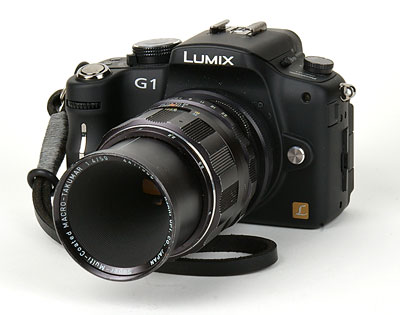 This is a Pentax Super-Multi-Coated Macro-Takumar 50/4 on my Panasonic G1. It's a Pentax M42 screw mount lens that I have for my Pentax Spotmatics. With a M42 adapter I can use it on my Panasonic G1. The crop factor on the G1 (smaller sensor that 35mm film) turns it into an effective 100mm lens. The thing that makes a macro lens a macro lens is the ability to move the lens elements further away from the sensor/film. That allows it to focus closer. The picture shows the lens fully extended.
 With the G1 and macro lens mounted on a tripod I approached some little flowers on our porch. The are about 1 inch (2.5 cm) accross at the max.
 This is with the macro lens fully extended. It is really easy using the old (1970s vintage) macro lens on the digital G1.
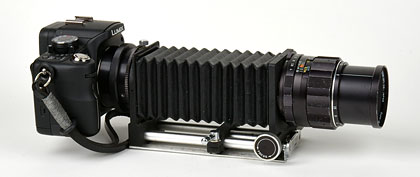 But wait! There's more! The macro lens can only extend so far. From there a macro bellows is needed. This moves the whole lens out further. This picture shows the bellows fully extended.
 Taken with bellows and macro lens near full extension. The bellows and macro lens are a great combination. There is a whole different world to be seen. I was blown away to see the water droplets. These photos will print 10x13 inches without upressing. More pictures on my Flickr set: Panasonic G1 Macro. The big problem getting these pictures was that every little breeze would set the flowers jumping around. Next I will try this with my studio strobe setup.
|
|